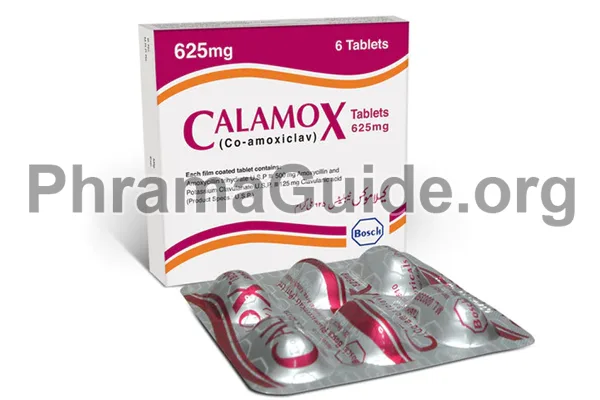Calamox is a combination antibiotic medication that is used to treat a variety of bacterial infections. Like all medications, Calamox can have potential side effects. Not everyone will experience these side effects, and some individuals may experience no side effects at all. However, it’s essential to be aware of the possible side effects and to inform your healthcare provider if you experience any of them.
Common Side Effects of Calamox
Gastrointestinal Distress: These are the most common side effects and can include diarrhea, nausea, vomiting, and abdominal pain. Taking Calamox with food can help reduce stomach discomfort.
Skin Rash: Some individuals may develop a rash while taking Calamox. If you experience a rash, especially if it is severe or accompanied by other symptoms like fever or itching, contact your healthcare provider.
Oral Thrush: Calamox can sometimes disrupt the normal balance of bacteria in the mouth, leading to Oral thrush (a fungal infection in the mouth). Maintaining good oral hygiene can help prevent this side effect.
Vaginal Yeast Infections: Calamox use can increase the risk of developing yeast infections in women.
Changes in Blood Tests: Calamox can occasionally affect blood tests, leading to changes in liver function tests or blood cell counts. These changes are typically reversible and resolve after discontinuation of the medication.
Headache: Some people may experience headaches while taking Calamox.
Less Common or More Severe Side Effects of Calamox
Severe Allergic Reactions: Although rare, Calamox can cause severe allergic reactions, such as swelling of the face, lips, tongue, or throat, difficulty breathing, and hives. Seek immediate medical attention if you experience these symptoms.
Diarrhea: Severe or persistent diarrhea, especially if it contains blood or mucus, may indicate a more serious condition called pseudomembranous colitis. If you develop severe diarrhea, contact your healthcare provider immediately.
Liver Problems: In rare cases, Calamox can lead to liver problems, including hepatitis (inflammation of the liver). Symptoms may include jaundice (yellowing of the skin or eyes), dark urine, or persistent abdominal pain. Inform your healthcare provider if you experience these symptoms.
Blood Disorders: Very rarely, Calamox may affect blood cell counts, leading to symptoms such as unexplained bruising, bleeding, or fever. Contact your healthcare provider if you experience these symptoms.
Nervous System Effects: Calamox can cause nervous system side effects, including confusion, agitation, and seizures. If you experience any of these symptoms, seek medical attention.
Kidney Problems: Although rare, Calamox can lead to kidney problems, such as interstitial nephritis (inflammation of the kidney tissue). Symptoms may include decreased urine output or swelling. Inform your healthcare provider if you experience these symptoms.

What is Calamox?
Calamox is one of the leading brands of Co-amoxiclav, manufactured and marketed by Bosch Pharmaceuticals, Pakistan.
Calamox : Available Formulations and Strengths
Presently, Calamox is available in Tablet, Drops, Syrup, and Injection forms.
Calamox Tablets : 375mg, 625mg, and 1000mg (1g) strengths
Calamox Drops : 62.5mg/5ml strength
Calamox Syrup : 156.25mg/5ml, 312.5/5ml, and 457mg/5ml strengths
Calamox Injections : 0.3gm, 0.6gm, and 1.2gm strengths
What Are The Possible Drug Interactions of Calamox?
Probenecid: Probenecid is sometimes used to treat Gout and may reduce the elimination of amoxicillin from the body, potentially increasing its blood levels. Your healthcare provider may need to adjust the dosage of Calamox if you are taking probenecid.
Allopurinol: Allopurinol, also used for Gout, can increase the risk of skin rashes when taken with amoxicillin or Calamox.
Methotrexate: Calamox may increase the levels of methotrexate (used to treat certain cancers and autoimmune diseases) in the blood, potentially increasing the risk of methotrexate-related side effects. Your healthcare provider will monitor your methotrexate levels closely if you are taking both medications.
Oral Contraceptives: Calamox can reduce the effectiveness of hormonal contraceptives, such as birth control pills. It is advisable to use an alternative method of contraception while taking Calamox and for a brief period afterward.
Anticoagulants (Blood Thinners): Calamox may increase the risk of bleeding when taken concomitantly with anticoagulant medications such as Warfarin or Heparin. Your healthcare provider may need to adjust your anticoagulant dosage and monitor your blood clotting parameters closely.
Other Antibiotics: Combining Calamox with certain other antibiotics, such as Tetracyclines or Sulfonamides, may reduce the effectiveness of both medications.
Methoxyflurane: Methoxyflurane, a volatile anesthetic used in some procedures, can interact with Calamox and lead to kidney damage. Avoid using methoxyflurane while taking Calamox or inform the healthcare provider administering anesthesia about your medication.
Proton Pump Inhibitors (PPIs): Some studies suggest that PPIs, such as Omeprazole and Esomeprazole, may reduce the absorption of clavulanic acid, potentially reducing the effectiveness of Calamox. If you are taking a PPI, discuss this with your healthcare provider.
Other Medications: Various other medications and supplements can interact with Calamox, so it’s essential to provide your healthcare provider with a complete list of all prescription and over-the-counter drugs, as well as any herbal or dietary supplements you are taking.
Related Links :

Leave A Comment